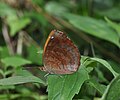| Angled castor | |
|---|---|
 | |
| Scientific classification | |
| Kingdom: | Animalia |
| Phylum: | Arthropoda |
| Class: | Insecta |
| Order: | Lepidoptera |
| Family: | Nymphalidae |
| Genus: | Ariadne |
| Species: | A. ariadne |
| Binomial name | |
| Ariadne ariadne | |
| Synonyms | |
Ergolis ariadne | |
Ariadne ariadne, the angled castor, is a species of nymphalid butterfly found in Asia. [1] [2]




